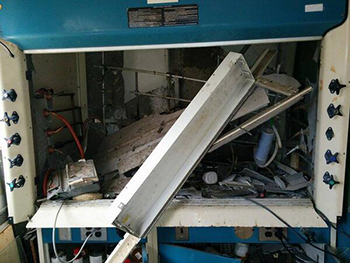When Trimethylsilyl Azide Preparation Goes Wrong
Recently an explosion at the University of Minnesota made the news. The explosion occurred when a 5th year graduate student was generating trimethylsilyl azide inside of a fume hood. The reaction detonated with a force so great that it broke all sides of the fume hood, damaged the neighboring hood and broke an exterior window. The student was fortunate to receive minor burns and wounds from the flying glass and was released from the hospital. The damage done by the explosion is clearly evident in the photograph of the fume hood below that was taken by the University of Minnesota.

The procedure for generating the trimethylsilyl azide is one that is commonly used in many organic chemistry laboratories and can be found here: Trimethylsilyl Azide Procedure. Caution must be used when synthesizing azide compounds because on one hand azido compounds themselves are potentially explosive and on the other hand the formation of hydrazoic acid is possible if small amounts of protic impurities are present in your starting materials (such as and the presence of water or mineral acids). Hydrazoic acid is an explosive chemical that is unstable and can decompose violently resulting in an explosion with tremendous force. Because of this, trimethylsilyl azide and azido compounds must be considered and handled as explosive materials.
When working with explosive chemicals there are two main sources of protective barrier available to protect you from flying debris– a blast shield and the fume hood sash. Blast shields should be positioned inside of the fume hood for the duration of the procedure and the fume hood sash must be lowered to the lowest point where you can still comfortably work inside of the hood, this is usually at the bend of your elbows while standing. The fume hood sashes are designed to be lowered to provide a physical barrier between the reaction in the fume hood and you so you should be looking through the sash at your equipment and glassware.
In addition to these protective barriers, you should also wear appropriate personal protective equipment such as a flame retardant lab coat, appropriate gloves, a full face shield and chemical splash goggles during the procedure. It is also recommended that tongs or other gripping devices are used to handle equipment and manipulate glassware. For more guidance on working safely with organic azides I recommend reading “Organic Azides, Syntheses and Applications” by Stefan Bräse and Klaus Banert.
Please ensure you handle explosive and potentially explosive chemicals with care and utilize small scale reactions. If you have any questions please feel free to contact me at leestone@iupui.edu for further guidance.
|